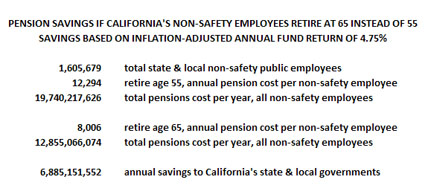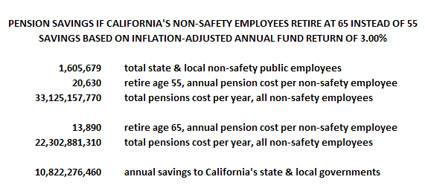Pension Funding & Rates of Return
In a March 18th interview (view video), California Gubernatorial candidate Meg Whitman expressed the problem with pensions quite accurately, stating “there is a current period cost of pensions, and that cost is only going to increase.” Whitman went on to say that CalPERS may lower the long-term rate of return they use for their pension fund earnings projections. One of the solutions Whitman offered to California’s pension crisis was to suggest California’s non-safety employees defer retirement from the current age 55 to age 65, and also for California’s non-safety employees to contribute 10% of their salary to their pension fund instead of 5%. How much will this help?
If we assume these reforms are applied at the local level as well – since most public employees in California work at the local level – the calculation of savings based on doubling the average employee contribution from 5% to 10% is fairly straightforward. There are about 1.6 million non-safety, non-federal public employees in California, and their average salary is $60,000 per year. If you take 5% of that, $3,000, and multiply by 1.6 million, you get nearly $5.0 billion per year in savings to the taxpayer. Is this significant? Will this help?
To answer this question, the biggest variable by far is what rate of return you calculate for the pension funds themselves. To illustrate this, consider the impact of Whitman’s other proposal, to raise the retirement age from 55 to 65 years old. As the table below indicates, if we were confident that CalPERS official inflation-adjusted rate of return of 4.75% were possible, these two reforms – raising the retirement age by 10 years plus doubling the employee contribution to their retirement fund – would nearly solve the problem. Raising the retirement age saves nearly $7.0 billion per year, and doubling the employee contribution throws another $5.0 billion into the pot. Suddenly pension funding for 1.6 million non-safety employees in California’s state and local governments only costs $7.0 billion per year, instead of $20 billion per year. Problem solved? Perhaps. On the other hand, when Pippin asked Meriadoc why they couldn’t just run back to the Shire to drink beer, tend their gardens, and smoke pipe-weed, Meriadoc said “Pippin, there isn’t going to be a Shire.”
 Let’s suppose you can’t assume long-term real rates of return of 4.75% for the following reasons: (1) trillion dollar funds can’t appreciate faster than the rate of general global economic growth, which over the past 60 years has averaged about 3.0% per year, (2) public equities over the past 85 years have appreciated at a real annual rate of 2.8% per year, (3) central banks are flooding the world with currency to stave off deflation, (4) money market funds are only returning 1.0% per year, (5) the stock market has been flat for the last ten years, (6) household and consumer debt is still at unsustainable levels and nobody is buying anything, (7) banks are holding foreclosed residential real estate assets to avoid further drops in asset values, (8) the commercial real estate market is hanging by a thread, (9) the bond bubble is about to pop, (10) we can’t extract abundant reserves of natural resources because environmentalists have successfully legislated or litigated development to a standstill, (11) the business community has given up and has decided the government is their new customer, and (12) public sector unions have taken over our state and local governments in California – demanding wages and benefits that are bankrupting us – and they are successfully exporting that model to other states and to Washington DC, guaranteeing the tax burden on job creating businesses will go up, not down.
Let’s suppose you can’t assume long-term real rates of return of 4.75% for the following reasons: (1) trillion dollar funds can’t appreciate faster than the rate of general global economic growth, which over the past 60 years has averaged about 3.0% per year, (2) public equities over the past 85 years have appreciated at a real annual rate of 2.8% per year, (3) central banks are flooding the world with currency to stave off deflation, (4) money market funds are only returning 1.0% per year, (5) the stock market has been flat for the last ten years, (6) household and consumer debt is still at unsustainable levels and nobody is buying anything, (7) banks are holding foreclosed residential real estate assets to avoid further drops in asset values, (8) the commercial real estate market is hanging by a thread, (9) the bond bubble is about to pop, (10) we can’t extract abundant reserves of natural resources because environmentalists have successfully legislated or litigated development to a standstill, (11) the business community has given up and has decided the government is their new customer, and (12) public sector unions have taken over our state and local governments in California – demanding wages and benefits that are bankrupting us – and they are successfully exporting that model to other states and to Washington DC, guaranteeing the tax burden on job creating businesses will go up, not down.
If all that isn’t enough, there is the simple demographic fact that we live in an aging world. The ratio of workers to retired people everywhere on earth is going to go up, inexorably, for decades to come. There are two ways to finance retirement security under these conditions – retire later in life, and increase worker productivity through innovation. CalPERS and CalSTERS are not going to game the system and escape this reality because they are too big. If the twelve factors just noted that are hampering economic recovery are addressed, productivity will accelerate its upward march, and everyone can enjoy a secure retirement. But today CalPERS and CalSTERS, because of the unrealistic projections they make and the impossible demands those projections enable, are part of the problem.
For these reasons, the chances we’re going to see inflation-adjusted 4.75% annual rates of return on trillion dollar investments are about as likely as Sauron deciding he’ll stop catapulting the heads of captured knights over the walls into the citadel of Gondor, and instead will instruct his armies of Orcs to plant flowers and learn how to play soccer. But if the fantasy saga of Middle Earth dealt in harsh realities, the actuaries at CalPERS are apparently still drinking beer under the party tree in Hobbiton.
To verify this, earlier this week I checked with an official at CalPERS to ask him whether or not they were going to lower their earnings projections. This is what he wrote in reply:
“These were only rumors that were circulating. Every three years the CalPERS Board reviews the asset allocation and only if they elected to change to a much more conservative asset mix would there be a change in assumption.”
This is an illuminating response, because it suggests CalPERS is still holding off on lowering their real (inflation adjusted) long-term projected return, which currently is 4.75% per year, and also because it suggests they have not moved their assets to a “much more conservative” mix of investments. This is consistent with a March 9th 2010 report by Leo Kolivakis, in his post entitled “Public Pension Funds Doubling Up to Catch Up,“ where he wrote:
“So what are public pension funds doing? Cranking up the risk, investing in failed banks, leveraging up, shoving more money in private equity and hedge funds, whatever it takes to achieve that insane 8% average annual return they’re all still fixated on.”
So how much will Whitman’s reforms matter if CalPERS can only earn 3.0% on their funds – after inflation? In the table below the same results are reported, based on a 3.0% real rate of return.
 When you use a rate of return of 3.0%, the estimated annual pension cost for California’s state and local non-safety employees is not $19.7 billion per year, as it would be using a rate of 4.75%, but $33.1 billion per year, nearly twice as much. It is difficult to overstate the financial impact of lowering this projected rate of return. This is best case, by the way, because these figures were calculated under the assumption that pension assets are fully funded today, and it also assumes the age of workers in California’s state and local governments are evenly distributed between those entering the workforce and those about to retire. In reality, California’s public employee pension funds are already underfunded and have to play catch-up, and the workforce is skewed towards a disproportionate number of workers who are nearing retirement. For these reasons, if you go with a 3.0% rate of return, the $33.1 billion annual cost is still understated. And nowhere in this analysis are the costs considered for state and local employees engaged in public safety. They comprise 13% of California’s state and local public sector workforce, and their retirement packages are significantly more generous than the non-safety employee packages discussed here.
When you use a rate of return of 3.0%, the estimated annual pension cost for California’s state and local non-safety employees is not $19.7 billion per year, as it would be using a rate of 4.75%, but $33.1 billion per year, nearly twice as much. It is difficult to overstate the financial impact of lowering this projected rate of return. This is best case, by the way, because these figures were calculated under the assumption that pension assets are fully funded today, and it also assumes the age of workers in California’s state and local governments are evenly distributed between those entering the workforce and those about to retire. In reality, California’s public employee pension funds are already underfunded and have to play catch-up, and the workforce is skewed towards a disproportionate number of workers who are nearing retirement. For these reasons, if you go with a 3.0% rate of return, the $33.1 billion annual cost is still understated. And nowhere in this analysis are the costs considered for state and local employees engaged in public safety. They comprise 13% of California’s state and local public sector workforce, and their retirement packages are significantly more generous than the non-safety employee packages discussed here.
The solution to California’s deficits is not to raise taxes. As housing prices shot upwards at a rate far exceeding inflation over the past 20 years, revenues from property taxes rose accordingly. Government tax revenues in California, from corporate taxes, individual income taxes, property taxes, sales taxes, and countless fees, total about $400 billion per year. This is plenty of money to run our state and local governments, if public employee pay and benefits are scaled back by about 20% across the board. For more, read “California’s Personnel Costs.” The benefits to the state’s economy would be immediate and profound.
If you want to know which California Gubernatorial candidate is most likely to make that prescription, flip a coin.

Edward Ring is a contributing editor and senior fellow with the California Policy Center, which he co-founded in 2013 and served as its first president. He is also a senior fellow with the Center for American Greatness, and a regular contributor to the California Globe. His work has appeared in the Los Angeles Times, the Wall Street Journal, the Economist, Forbes, and other media outlets.
To help support more content and policy analysis like this, please click here.

“Anyone who has read the Lord of the Rings can’t be all bad.”
Charles Sainte Claire
“Anyone who hates children and dogs can’t be all bad.”
W. C. Fields
“There are lies, damn lies and statistics”.
Mark Twain.